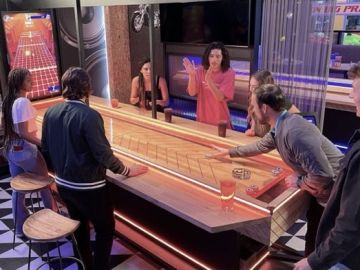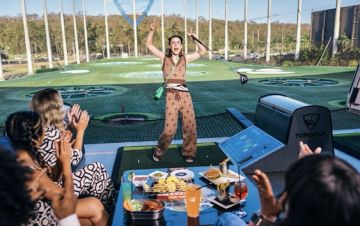
Vol. XXV, No. 4, April 2025
What is social gaming, and what is not?
As CEO of our company, I've worked in the community location-based entertainment (LBE) industry for over 36 years. I continue to be amazed when a new LBE concept emerges, how inappropriate and misleading a name it is given, which in turn becomes a flawed venue paradigm that leads many LBE entrepreneurs astray.
When community LBEs first emerged in the late 1980s and early 1990s, they were named family entertainment centers (FECs). As a result, even Dave & Buster's, a 100% adult-oriented LBE, was called an FEC. In the decades that followed, way too many LBE developers have taken the industry name literally to their detriment, believing success required designing for the family, a little bit of something for every age group. Unfortunately, even to this day, IAAPA continues to call it the family entertainment center industry when there are so many age-targeted concepts like children centers such as Chuck E Cheese and adult centers such as Dave & Buster's.
Five years ago, the pandemic denied us out-of-home socialization. When things opened back up that isolation fed people's desire for out-of-home social interaction. That, coupled with the foodie movement, has been the driver of a new LBE model that, from day one, has been incorrectly named with the oxymoron 'competitive socializing.' Socialization is not competitive. That's just stupid.
Research has consistently found that the primary reason people go out, whether to an entertainment venue, restaurant, concert, museum, sporting event, festival, or any other out-of-home leisure destination, is to socialize with family and friends. We evolved as a social species. We survived as a species by being tight-knit and cooperative members of families, tribes, and larger groups. We are hardwired by evolution to crave social interaction. Our need to connect with other humans is as fundamental as our need for food and water.
Perhaps whoever first popularized the term competitive socialization for the new LBE concept was trying to capture the idea that people were playing games that looked competitive. The mistake is that if the game is competitive, it destroys the socialization. People are focused on the play and score, not socializing with others in the group. The correct name for the new LBE formula is 'social gaming eatertainment,' or just 'social gaming' for short, as enjoying quality food and beverage while playing the game is essential to create the highly interactive social experience that is the appeal of social gaming venues. This differentiates it from typical eatertainment where the venue has games and food and drink, but they are enjoyed at different times.
So, what are the requirements for social gaming?
- The games are analog, often technology enhanced. The games need to be ones everyone can casually play and have fun, no matter their skill level. People don't want to play a game that makes them score poorly compared to other players. The game must have a low skill-level variance, the difference between a first-time and skilled player. Low-skill level games are easy to learn and easy to play. With some practice, you can play against another player who already knows how to play. Any competition the game may create must be very light-hearted and not taken seriously. Rather than competitive games, they are casual social games.
- The best social gaming venues feature destination-worthy, trend-forward, foodie-worthy, globally-inspired menus with sharable dishes and curated beverage and alcoholic selections. The food and drink never play second fiddle to the social games. Instead, it is as important, if not more so, to create a high-fidelity social experience. Remember, we now live in the foodie era of adventure and discovery. Dining and drinking out is considered a fun, social experience, even qualifying as an entertainment experience, often with more appeal than the entertainment itself.
- A critical requirement of social gaming, differing it from typical eatertainment, is that the food and drinks are enjoyed simultaneously while playing, combining them and the game play into a single experience.
- The games have to have a particular rhythm where one person plays while the other people watch, converse, socialize, validate the play of each other, and enjoy food and drinks. Each person's turn only takes a few minutes, so that person isn't left out of the conversation long enough to lose its thread.
So, precisely what games qualify for social gaming?
- Bowling - Bowling can go either way. With tenpin bowling, having an experienced bowler in the group who probably bowled in a league for years and always scores high can take the fun away for a novice or less experienced person who frequently gets gutter balls. This is why duckpin bowling dominates social gaming venues; as it is a new game and it puts everyone at the same skill level, with no or very little skill level variance.
- Darts - The newer electronic dart games, such as at Flight Club or Krazy Darts sold by Lasertron, have a very low skill level variance.
- Axe Throwing - A very low skill level variance makes axe throwing a good fit for social gaming.
- Golf driving range - The reimagined driving range concept by Topgolf and its imitators is 100% social gaming.
- Indoor golf simulators - Golf simulators in venues such as Topgolf Swing Suites and Five Iron Golf fit the social gaming requirement.
- Table shuffleboard - With a low skill-level variance, the execution of the shuffleboard at Electric Shuffle with the adjoining counters for food and drink fits the requirements.
- Pool/billiards - Pool and billiards have the right rhythm and fit, provided any players aren't highly experienced, creating a high skill level variance, just like what can occur with tenpin bowling. There can be adjoining tables or counters for the food and drink.


A requirement to make all the above games social gaming is the simultaneous opportunity to enjoy drinks and food when not playing, preferably shareable. This makes the furniture layout critical. Topgolf's seating and table layout is a great example. Electric Shuffle's addition of adjoining counter space is what converts table shuffleboard into social gaming.
The following games don't fit the requirements for social gaming:
- Ping pong - This lacks the rhythm of just one person playing and food and beverage at the same time as the play. If everyone plays simultaneously, they're too focused on their play to be social. It's really a competitive sport.
- Mini golf - This has the right player rhythm, with one player briefly playing while the other players watch and socialize, but it lacks simultaneous drink and food. Some venues include drink stands at each hole so players can take their drinks with them from hole to hole. This helps but doesn't match the fidelity of the social experience social gaming offers with simultaneous food, especially shareable food.
- Outdoor shuffleboard - with four players, the players are split up with two players at each end of the court, so there is no group socialization, nor are there provisions to enjoy food and drink while playing.
- Pickleball - Pickleball is a very approachable sport that has gained popularity as an attraction in many entertainment venues. It is a competitive sport with everyone playing simultaneously, the opposite of a social gaming experience.
- Bocce - this is a team game, really a sport, and lacks the simultaneous food and drink.
- Driving simulators - This is a competitive activity without the simultaneous food and drink.
Although the above games and many others can be combined with food and drinks areas in an eatertainment venue, they cannot create the appeal of the high-fidelity social experience that social gaming offers.
The post-pandemic desire for high-fidelity, out-of-home social interaction combined with a passion for quality food and drink experiences will drive the continued growth of social games, possibly making it the new norm for LBE development.
Subscribe to monthly Leisure eNewsletter



